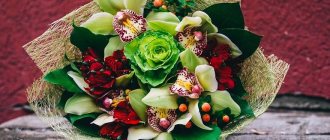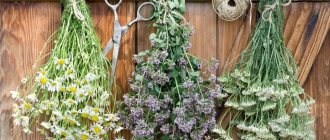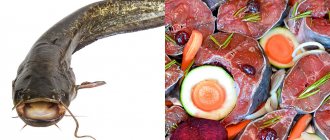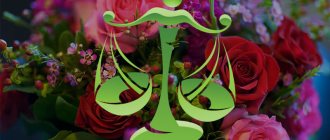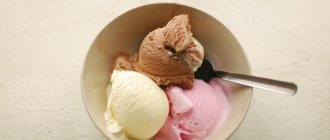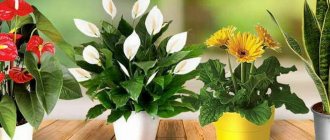Allergic reactions to indoor flowers have recently become a common problem that can be faced by both adults and children. Allergies to indoor flowers often develop for a number of reasons.
The desire to grow indoor plants to decorate your home and bring more comfort and beauty into it is common to every person. Green spaces on windowsills improve mood, help relieve stress, and improve well-being, but only in cases where they do not cause allergic manifestations.
An allergen can be the plant itself, pollen during its flowering, or mold that forms on too wet soil in a flower pot.
To find out what house flowers you may be allergic to, you should understand the reasons for its occurrence.
Causes of allergic reactions
While cultivating green spaces, a person may notice the following symptoms: constant runny nose, sneezing, puffy eyes, incessant cough. Often the patient mistakes the symptoms of an allergy to indoor flowers for an infectious or cold disease, without stopping contact with the allergen.
There are a number of reasons that contribute to the development of allergies to green spaces:
- A predisposition of the body, manifested by allergies to food, household chemicals, indoor dust or certain types of mold, hair or fluff of pets, etc.
- External factors that reduce the body’s protective properties: poor environmental conditions, living in areas with high gas pollution, cigarette smoke.
- Types of flowers that pose a danger to allergy sufferers, which are unknowingly grown at home.
Allergy to wild and domestic flowers often manifests itself in the form of hay fever (allergic manifestations to pollination of flowers). The main source of trouble in such cases are wild shrubs and trees, which bloom in late spring and early summer.
During this period, an allergy to indoor flowers may begin, and the symptoms of the disease will be similar to those of hay fever.
Often, negative manifestations on the flowering of indoor plants are not associated with pollen at all. An allergic reaction of the body can be triggered by the soil in which the plant is planted. Allergies develop to various types of soil amendments that are used as fertilizers.
Mold, which develops on the soil in cases where the flower is not properly cared for, is also an allergen. Excessive watering is necessary only for moisture-loving plants; otherwise, some of the water remains in the soil, causing the development of mold on its surface and on the walls of the flower pot.
Direct contact with some types of indoor flowers can lead to skin dermatitis. The stems, leaves or roots of the plant in rare cases cause a violent allergic reaction when touched.
In such cases, the following symptoms of the disease are most often diagnosed: skin rashes such as urticaria, rash all over the body, especially in places of contact with the plant (hands, wrists), severe itching.
Juice from the leaves of a number of indoor flowers can also cause unpleasant manifestations, for example: orchid juice is dangerous if it gets on the mucous membranes, because the plant is considered poisonous. Young children often taste the bright flowers and beautiful leaves of home gardens.
Poisonous juice can provoke a violent reaction in the body, including the development of anaphylactic shock.
Allergy to flowering and medications for it: symptoms and treatment
Seasonal allergies to flowering trees and plants are one of the most common diseases. The disease is called hay fever and, according to statistics, ranks 2nd in the world.
Symptoms of an allergy to flowers appear with the first warm days, but often symptoms are observed throughout the year, for example, if the patient grows flowers at home.
Before undergoing therapeutic drug treatment or taking up traditional healing methods, you should find out all the factors that cause the disease.
Risk factors and symptoms of the disease
Medicine lists several causes of intolerance:
- Heredity. If one or both parents in a family have diseases of this type, the risk of manifestation in the child is 50-75%.
- Poor nutrition.
- Living in an area where the surrounding nature is excessively polluted.
The overwhelming majority of cases occur at a very early age. The pathology is characterized by periods of exacerbation and long-term remissions. It is not difficult to determine the occurrence of intolerance; the pathology is formed when particles of plant pollen are inhaled. Allergens irritate the mucous membranes of the nose, eyes and body, causing a reaction similar to cold symptoms:
- Itching in the nose, mouth, eyes;
- Sneezing, cough (sometimes dry, exhausting);
- The eyes become watery, conjunctivitis (redness of the sclera) appears;
- The skin itches, spots of redness and a rash appear.
Respiratory signs are always pronounced. And in order not to confuse allergies with a common cold, you should note the frequency of manifestations: in dry, hot weather, all symptoms intensify.
If you are allergic to flowering, you should not endure illness for long: constant poisoning leads to suffocation, and after a few years the disease will cause bronchial asthma. Normal intolerance to plant pollen can be fatal if the patient simultaneously receives a large dose of the allergen and there is no timely help.
Causes of intolerance
If an allergy to flowering occurs, the reasons lie specifically in the human immune system. Particles entering the body are taken as foreign and harmful, so the immune system begins to develop special complexes.
An intolerance reaction occurs and inflammatory mediators cause all the symptoms.
If you do not cure allergies or at least do not take seasonal medications, year after year the pathology will only get worse and develop into more serious diseases.
A few facts:
- The more often a child suffered from respiratory, viral, and bacterial diseases in childhood, the higher the risk of hay fever.
- Residents of rural areas get sick much less often, despite the fact that they come into contact with nature more often.
- Children who are breastfed by their mothers get sick less often than those born artificially; the diet in the first years of the baby’s life is also important.
Residents of cities where there are hazardous industries suffer from hay fever much more often than residents of huge cities, but without such enterprises. This is due to the gradual accumulation of harmful substances in the body and subsequent reactions of the immune system.
The main plants and trees that cause signs of allergies:
- Birch. It was found that pollen from birch catkins causes the most unpleasant and painful manifestations of hay fever;
- Alder;
- Poplar (fluff);
- Pine;
- Oak;
- Hazel.
The flowering period of plants occurs in spring-summer, but everything depends on specific climatic conditions. Plants that cause allergies:
- Nettle;
- Ambrosia;
- Sagebrush;
- Plantain;
- Quinoa.
Here the flowering period is limited to July-August. The cause of symptoms can be the flowering of timothy, rye, and cereals cause a long and sluggish course of the disease.
Allergies to indoor plants can occur at any time and the discomfort lasts for quite a long time. Symptoms most often appear if there is:
- Azalea;
- Geranium;
- Oleander;
- Kalanchoe;
- Cyclamen;
- Ferns;
- Monstera;
- Ficus.
Manifestations of intolerance occur not due to the plants themselves, but also to other factors: incorrect or insufficient care or the use of fertilizers containing a certain allergen.
Treatment of the disease
Treatment of allergy to flowering begins with finding out the main causes of the ailment, for which allergy tests are taken. The procedure takes a little time, but it allows you to find out all the risk areas.
It should be remembered that it will not be possible to completely get rid of intolerance; medicine for flowering allergies will reduce the intensity of manifestations and stabilize the patient’s condition.
Before issuing recommendations, the specialist carefully analyzes the symptoms and treatment is prescribed taking into account the clinical picture.
Drug therapy includes antihistamines and medications, and folk remedies are allowed.
Important! Starting to take medications on your own is strictly prohibited! Doctors remind that not all drugs have an equally good effect on various symptoms of intolerance, therefore the selection of drugs should be made only on an individual basis. Only a specialist will select a treatment regimen and prescribe hyposensitization. This is a procedure for introducing a certain amount of allergens to reduce the sensitivity of the body and reduce the manifestation of negative symptoms.
Allergy medications
When figuring out how to treat allergies, you should remember: the main treatment is to limit contact with the plant that causes negative reactions. But it is not always possible to move to another area, so you have to use allergy medications, they are divided as follows:
- Antihistamine tablets for flowering allergies do not suppress metabolic processes by blocking receptors.
- Mast cell stabilizers are drugs used when other medications are not effective or when there are serious contraindications. Nedocromil and Cromolyn are considered the best. Treatment is achieved by suppressing the release of allergic mediators and mast cells.
- Anti-inflammatory drugs are used orally and are especially effective in cases of increased severity (allergic dermatitis, seasonal asthmatic manifestations).
- Anti-leukotriene medications are compounds directly aimed at healing the disease during seasonal flowering of plants.
- Immunotherapy is prescribed if all of the above methods are ineffective.
The list of medications is quite large; they should be taken only after examination by a specialist:
- Suprastin, Zyrtec - antiallergic agents.
- Visine, Systane - drops for allergic conjunctivitis that affects the eyes.
- Naphthyzin, Galazolin - drops or sprays that should be taken during an exacerbation of rhinitis. Cause a vasoconstrictor effect.
Important! Drops are prescribed only periodically (for a period of no more than 10 days), their constant use leads to addiction.
It’s a good idea to take a course of vitamins or immunomodulators along with medications to increase the body’s resistance. In addition to medications, changing your diet helps. All foods rich in allergens should be removed from the menu.
These include: honey, plums, apples, kiwis, tomatoes, carrots, berries (strawberries, raspberries), baked goods, alcoholic drinks. To support the body, fermented milk products are introduced into the diet - beneficial bacteria stimulate the intestines, which increases the body's resistance to allergens.
Give up juices and drink more regular clean and still water - all negative substances will be washed out of the blood and organs faster and the disease will recede much faster.
Traditional medicine recipes
You can combat pollen intolerance with herbs. Sometimes the allergy goes away by taking a shower and gargling. The following plants are very effective:
- Calendula decoction is prepared from 10 inflorescences, brewed with a glass of boiling water. Leave the infusion for half an hour, then strain and take 1 tbsp. l. 3-4 times a day. The decoction helps with severe allergic irritation of the mucous membranes.
- Chamomile decoction is prepared from a large spoon of dry chamomile, filled with 1 tbsp. boiling water Cook for 30 minutes in a water bath, strain, drink a tablespoon at a time until the irritant continues to bloom.
- Red clover inflorescences help when severe allergies affecting the eyes begin. The juice is squeezed out with your fingers, mixed in a ratio of 1:4, for 1 part juice take 4 parts cool boiled water. Wash your eyes with the solution and apply lotions no more than 3-4 times a day.
- The infusion of the series is prepared like regular tea, but the course of treatment lasts at least 5 years. The amount of color is taken to obtain a drink of a bright golden color; there are no dosages to drink - the folk remedy has practically no contraindications. Therefore, drinking tea from a series will be useful for any person who has problems with the beginning of the flowering period of plants.
It is better to collect the herbs and other herbs yourself while the plants have not yet bloomed, but you can buy pharmaceutical packages. Treatment with folk remedies, like drug therapy, is not quick. Therefore, to the question: how much to drink products and compositions, the answer will be one - for a long time.
Prevention of exacerbations
There are ways to get rid of allergies, or rather their severe manifestations. A few simple tips will help reduce the intensity of symptoms:
- Change your diet by introducing foods that have a supporting effect on the digestive system.
- Clear your nasal passages in a timely manner. Nasal rinsing is an effective means of removing allergens that enter the body through inhalation of pollen.
- Minimize your time spent outside, especially in dry, hot weather.
- Close windows and vents tightly at home - even if the plants in your yard have not bloomed, the wind can bring pollen from anywhere.
- Wet cleaning of the house is the best way to reduce the manifestations of pathology.
Important! What to do when reactions occur in adults is a settled issue, but with children the situation is much more complicated.
Children cannot always say that they do not have a cold, and snot and cough are perceived by parents as acute respiratory infections.
A specialist will best understand the issue of allergies to flowers, symptoms, and treatment, so you should not postpone a visit to the doctor, especially if the child has seasonal symptoms.
Rate this publication: Loading...
Source: https://IDermatolog.ru/allergiya/simptomy-allergii-na-cvetenie-i-ee-lechenie.html
Houseplants that trigger allergies
There are a number of colors that most often cause allergic reactions. If you have a baby in the house, or one of the family members suffers from seasonal or food allergies, you should stop raising them at home.
Strong allergens that are dangerous in direct contact with them include:
- Razia, plumeria, carissa, strophanthus, dipladenia, oleander, adenium (cutrove family). All parts of the flowers of this family can provoke severe allergic reactions. Leaf juice that gets on mucous membranes is especially dangerous.
- Lily (lily family). The peculiarity of the flower is that at night and in the evening it releases carbon dioxide into the air in large quantities, which causes severe headaches and disrupts sleep. The leaves and flowers contain poisonous juice and can be a source of contact allergies.
- Monstera, Diefenbachia, Calladium, Alocasia, callas (Araceae family). In parts of plants, the presence of substances such as: Asparagine and oxalic acids was detected; when the juice gets on the mucous membranes or skin, an allergic reaction instantly develops. Many people are interested in whether spathiphyllum is an allergenic flower? Yes, because he belongs to the same family.
- Akalifu, poinsettia, jatropha, croton (Euphorium family). Leaf juice can cause serious burns to the skin or mucous membranes.
- Brunfelsia, capsicum, brovallia, false nightshade (nightshade family). Bright leaves and fruits often make children want to taste them, which leads to negative consequences.
But even the juice of a medicinal plant, such as Kalanchoe, can become an allergen if you are hypersensitive.
There are a number of indoor plants that provoke allergies by their presence indoors, these include:
- evergreen ivy,
- azalea,
- gloriza,
- aglaonema,
- plumeria.
Concerned about allergies to flowers
One of the saddest allergic diseases is an allergy to flowers. It’s especially offensive for female representatives at such moments, because they so love attention from bouquets. Allergy to flowers is also commonly called hay fever.
Causes of allergies to flowers
There are about 700 flowers and plants that can cause allergies. The following are the reasons for its appearance:
- Sensitive nasal mucosa.
- The action of the reagin mechanism as a result of microparticles of plants or pollen entering the body, which increases the production of histamine and serotonin in the human body.
Allergies to plants and flowers can be hereditary, therefore, when purchasing them, it is advisable to ask your parents if they have such a problem.
Weather conditions (rain and drought) create obstacles to the appearance of pollen, which in turn reduces its concentration in the air. This significantly reduces the risk of allergies.
You may also be allergic to indoor plants. If there are allergy sufferers in the family, then you should not have plants in the house that can cause symptoms of the disease:
- poinsettia;
- spurge;
- geranium;
- primrose;
- mile;
- Kalanchoe.
Eliminate the appearance of poisonous plants in the house:
- dieffenbachia;
- aglaonema;
- monstera.
Factors that increase the risk of allergies:
- decreased immunity;
- use of antibiotics;
- direct contact with floral dyes and chemicals.
Symptoms of allergy to flowers
This type of allergy worsens in spring and summer, when everything around is fragrant. Signs of an allergy:
- Nasal congestion and itching on the nasal mucosa appear.
- Itching in the throat and eyes.
- Sneezing.
- Copious production of tears, redness of the eyelids.
- Conjunctivitis, as well as a feeling as if there was sand in the eyes.
- Noise and pain in the ears.
- Rash on the skin.
If the symptoms recur annually, then we can say with confidence that it is an allergy to a certain flower.
Over time, they can intensify and worsen, becoming longer lasting if the plant or flower that causes the allergy is not identified.
This is fraught with side effects such as non-perception of strong odors, dust and increased temperature. The following symptoms are inherent in the deterioration of the condition:
- suffocating cough;
- attacks of suffocation;
- all kinds of dermatitis and bronchial asthma.
Treatment of allergies to flowers and plants
Before you start treatment, you should know for sure what problem you are facing. To do this you need to carry out diagnostics.
First of all, you need to determine the nature of the disease, what exactly caused the allergic reaction. Often people diagnose themselves at home without even suspecting that the symptoms that arise may appear due to taking medications, and not through the presence of plants in the house.
An important point is the establishment of heredity.
To determine this factor, medical professionals are required to collect a complete history, which will help characterize the relationship of allergic manifestations with the environment.
Skin tests help identify the plant or type of plant that is causing the allergy. Using a test, you can determine to what extent the body is affected and the nature of the disease.
To prescribe correct and effective treatment, if the slightest symptoms appear, you must contact an allergy diagnostic center for consultation with a specialist.
The first need is to remove all plants that cause allergies. If the allergic signs to any flower are weak, then it is enough to simply limit it from yourself.
You should definitely consult an allergist so that you can determine which flowers or plants cause allergies. After the examination, the specialist will prescribe medication. Drugs that are most often used in the treatment of allergies:
- Tavegil. Available in the form of syrups or tablets.
- Suprastin. Release form: tablets.
- Fenkarol. Release form: tablets.
- Pipolfen. Release form: pills.
- Peritol. Release form: tablets.
- Zyrtec. Release form: drops.
It is undesirable to use the same drug, as the body gets used to it, the drug stops working, which delays recovery.
You should always carry the drug with you so that, if necessary, you can quickly respond to an allergy.
It is enough to avoid irritants and take medications so that seasonal allergies do not affect the body. The period of such allergies is on average up to 2 months. But an allergy to indoor flowers or to a certain type of flowers requires other measures. In addition to drug treatment, complete exclusion of the irritant for life is required.
Flower allergies cannot be ignored. This will have a very bad effect on the immune system in the future. The person will become sick and susceptible to various types of infections.
Allergy to flowers is not a diagnosis.
When the first signs of an allergy appear, there is no need to panic and take everything, but seek qualified help from a specialist who will conduct an examination and prescribe the correct treatment.
You can resort to folk remedies in the fight against hay fever:
- A decoction of oats will cleanse the body and relieve allergies.
- For 7 days, regularly eat small portions of porridge (they need to be cooked in water): barley, oatmeal, rice, wheat.
- Drink plenty of salted water, which will make it possible to remove toxins from the body.
- You need to dilute 1 g of mumiyo per 1 liter of water. Take half a glass once a day. This course should be completed for 20 days. Mumiyo perfectly improves immunity.
- You can perform therapeutic exercises.
A person suffering from allergy symptoms caused by plants for a long period of time needs to replace coffee (tea) with an infusion from the series. Brew 1 tsp. herbs 0.5 liters of boiling water. Leave for 20 minutes. Drink a glass 3 times a day. The duration of the course is from 3 to 4 months. Be sure to take a break for 4 months.
For a month you can take an infusion of calendula flowers, then for the same period take an infusion of chamomile, coltsfoot, violet, clover and plantain.
When using traditional methods (herbal medicine) to treat hay fever, you need to be extremely careful, and then the result will not be long in coming. Do not use allergenic plants under any circumstances, this will only worsen the situation.
https://www..com/watch?v=yAeJCfOD2Rc
How to prevent allergies to flowers and plants
So that nothing can cause allergies, you need to be careful about different types of flowers and plants. If a person has allergies, the following rules will need to be followed:
- Be sure to visit a specialist so that he can prescribe antihistamines. Taking them will be necessary during the flowering of a particular flower (plant).
- During the period when the irritant blooms, you need to limit your walks on the street, especially in the morning.
- You will need to exclude from your use all cosmetic products (shower gel, perfume, lotions, etc.) that contain floral scents.
- When going outside, you should wear glasses and, if necessary, a respirator. Upon arrival home, thoroughly wash your face, especially your nose and eyes.
- It is not recommended to bring flowers and herbariums into the house. Give up such a profession as a florist.
- Open windows for ventilation only at night (in the evening). And it is advisable to cover the window with wet gauze if you do open it during the day.
- Wet clean the house daily.
- Eliminate all indoor plants that cause allergies from your home.
- You should not go out of town during abundant flowering of plants.
https://www..com/watch?v=CHUQbQm2DUY
You need to exclude foods containing allergens from your diet.
Source: https://upraznenia.ru/allergiya-na-cvety.html
Symptoms
Symptoms have different etiologies, but most often manifest themselves as follows:
- the person’s eyes turn red, the eyelids swell, and uncontrollable lacrimation begins;
- allergic rhinitis develops, accompanied by copious secretion of mucus from the nasal passages, sneezing and swelling;
- a dry cough appears;
- the skin on the face itches, skin rashes occur throughout the body (urticaria, dermatitis, neurodermatitis);
- in rare cases, a feeling of nausea appears, body temperature rises, and blood pressure rises.
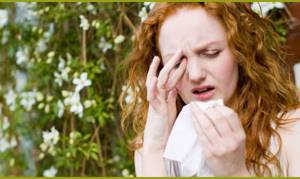
In severe cases of an allergic reaction, an attack of bronchial asthma, Quincke's edema, and anaphylactic shock may develop.
Symptoms of hay fever
In the middle zone, allergists distinguish three periods of flowering of plants. In April - May the trees bloom; June - July is the time of dusting of cereal grasses; from July to August - weeds.
Depending on susceptibility, an allergy may be observed to one or more types of plant pollen. For some people, allergic manifestations develop with the onset of spring flowering and do not subside until autumn.
Hay fever, which appears for the first time, can easily be confused with ARVI or conjunctivitis. Therefore, many people consult a doctor only after a year, when they notice the seasonality of the disease. Along with typical symptoms, seasonality serves as an additional factor in diagnosis.
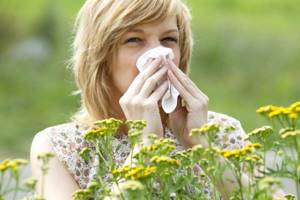
A person may be concerned about:
- Nasal congestion, frequent sneezing.
- Deterioration of sense of smell.
- Watery discharge from the nose.
- Redness and itching of the eyelids, swelling of the eyes.
- Dry cough.
- Rashes on the body.
In addition to respiratory symptoms, some patients experience symptoms such as excessive fatigue, deterioration of mood, appetite, and sleep disturbances.
The difference between pollen allergy and ARVI is the absence of an increase in temperature, although some experts talk about the possibility of fever in rare cases (in 5% of patients). If the allergen enters the esophagus, reactions from the gastrointestinal tract are possible - nausea, epigastric pain.
If the bronchi are involved in the allergic process, attacks of suffocation similar to bronchial asthma may occur. If an allergy to flowers appears in childhood, there is a risk of developing pollen asthma, especially during the period of hormonal changes in adolescents. Therefore, treatment of children is aimed not only at relieving bothersome symptoms, but also at preventing asthma.
Diagnosis and treatment
Diagnostics includes the following steps:
- examination by an allergist;
- taking anamnesis;
- taking blood tests to detect elevated histamine levels;
- conducting skin tests;
- prescribing tests to identify the allergen.
Treatment of an allergic reaction is directly related to the age of the patient and the type of allergic manifestations.
A mandatory point is to eliminate any contact with the allergen.
The following medications are prescribed to an adult:
- Antihistamines in the form of tablets (take course) to relieve allergic manifestations. Most often used: Loratadine, Tavegil, Claritin, Cetrin.
- Nasal drops for symptoms of allergic rhinitis, they help relieve swelling, reduce itching, and stop the secretion of mucus from the nasal passages. Avamis drops are an effective drug.
- Ointments and gels. If skin rashes appear, non-hormonal ointments and gels should be used. The drug Akriderm and Akriderm GK are highly effective.
- Sorbents. Sorbent preparations are prescribed as complex therapy to quickly eliminate unpleasant symptoms and remove toxins from the body.
Expert opinion
Allergist Yulia Borisovna Cherkashina
Education: Medical University named after. N.I. Pirogov, Moscow, 1998
To treat a small child, the doctor draws up a scheme that takes into account the age and strength of allergic manifestations.
Self-medication of the baby is unacceptable; it can lead to irreversible consequences.
Prevention measures
Preventive measures include the following:
- careful selection of plants for cultivation at home;
- proper care for them;
- choosing a place for home decor (do not place poisonous flowers with bright fruits and leaves in places where a small child can reach them).
There are a number of indoor flowers to which allergic reactions develop extremely rarely, these include:
- lemon, green tree leaves release essential oils and phytoncides, disinfecting the air in the room;
- Agave (aloe) and Decembrist are medicinal plants widely used in medicine;
- pelargonium, a flower that purifies the air and helps get rid of mosquitoes;
- begonia, it moisturizes and purifies the air, releases phytoncides;
- nephropelis fern, the leaves of the plant produce a huge amount of oxygen;
- hibiscus - considered the safest for a child's room.

